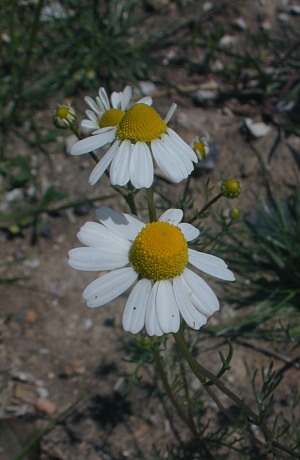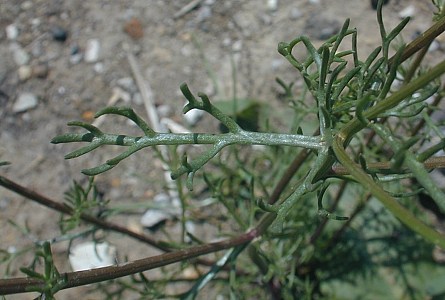Description:
This
herbaceous
plant is an annual that becomes 1-2' tall, branching
occasionally to frequently. The stems are light green, purplish green,
or purple with fine longitudinal veins; they are glabrous and terete
(round in cross-section). The alternate leaves are up to 3" long and
1½" across; they are green to dark green and double- or
triple-pinnate. The leaves occur rather sparingly along
the stems; they
are sessile or have short petioles. The leaf segments are
linear-filiform and glabrous. Each upper stem usually terminates in 1
or 2 daisy-like flowerheads. Each flowerhead spans about 1-2" across;
it consists of 10-20 white ray florets that surround numerous yellow
disk florets. The ray florets are oblong and petal-like; they spread
outward or droop downward, depending on the maturity of the flowerhead.
The tubular disk florets are arranged densely together on a receptacle
that is globoid, subgloboid, or conical: the shape of this receptacle
depends on the maturity of the flowerhead. There are no chaffy scales
on the receptacle and it is hollow inside. At the base of each
flowerhead, there are 1-2 series of floral bracts; these bracts are
light green, lanceolate, and membranous along their margins. Each
flowerhead has a naked peduncle (or flower stalk) at its base of
varying length. The crushed flowerheads have a fruity fragrance,
resembling pineapple or apple; sometimes the crushed leaves are
fragrant as well. The blooming period usually occurs during the summer
and lasts 1-2 months; some plants may bloom a little earlier or later
than this, however. Each disk or ray floret is replaced by a small
oblongoid achene. Each achene is nearly terete and has several fine
ribs. The root system is mostly fibrous. This plant spreads by
reseeding itself.
occur rather sparingly along
the stems; they
are sessile or have short petioles. The leaf segments are
linear-filiform and glabrous. Each upper stem usually terminates in 1
or 2 daisy-like flowerheads. Each flowerhead spans about 1-2" across;
it consists of 10-20 white ray florets that surround numerous yellow
disk florets. The ray florets are oblong and petal-like; they spread
outward or droop downward, depending on the maturity of the flowerhead.
The tubular disk florets are arranged densely together on a receptacle
that is globoid, subgloboid, or conical: the shape of this receptacle
depends on the maturity of the flowerhead. There are no chaffy scales
on the receptacle and it is hollow inside. At the base of each
flowerhead, there are 1-2 series of floral bracts; these bracts are
light green, lanceolate, and membranous along their margins. Each
flowerhead has a naked peduncle (or flower stalk) at its base of
varying length. The crushed flowerheads have a fruity fragrance,
resembling pineapple or apple; sometimes the crushed leaves are
fragrant as well. The blooming period usually occurs during the summer
and lasts 1-2 months; some plants may bloom a little earlier or later
than this, however. Each disk or ray floret is replaced by a small
oblongoid achene. Each achene is nearly terete and has several fine
ribs. The root system is mostly fibrous. This plant spreads by
reseeding itself.
Cultivation:
Naturalized plants are typically found in open areas that are sunny and
moist to slightly dry, where the soil consists of loam or clay-loam.
Other soil types are probably tolerated as well.
Range & Habitat:
German Chamomile naturalizes occasionally in southern and west-central
Illinois, while it is uncommon or absent elsewhere (see Distribution
Map). It was introduced from Europe into North America as an
ornamental plant
and garden herb. In Illinois, typical habitats for this species include
disturbed meadows, vacant lots, areas along roads and railroads, and
waste areas. German Chamomile is still grown in flower and herbal
gardens, from which it occasionally escapes. Usually, populations of
these escaped plants don't persist for very long. Disturbed open areas
are preferred.
Faunal Associations:
The nectar and pollen of the flowerheads attract small bees and various
flies primarily. Less common visitors of the flowerheads include small
butterflies, wasps, beetles, and plant bugs.
Photographic
Location:
Along a barren roadside in Urbana, Illinois. The leaf of the lower
photograph may have some mildew.

Comments: Several species of plants with white daisy-like flowers have been introduced from Europe; the classic example is Leucanthemum vulgare (Ox-Eye Daisy). They are often difficult to distinguish from each other. German Chamomile (Matricaria chamomilla) can be distinguished from other species in this group by its fragrant crushed flowerheads, which are hollow on the inside, and by its linear-filiform leaves. Similar species have flowerheads that lack a pleasant fragrance, or their flowerheads are solid inside; many of these species have leaves that are flat and narrow, rather than terete and worm-like (filiform). The flowerheads of German Chamomile often have receptacles that are more conical or ovoid in shape than those of other species in this group (which tend to have flatter receptacles). However, the shape of its receptacles varies significantly with the maturity of the flowerheads. Other common names that are sometimes applied to this wildflower are Wild Chamomile, False Chamomile, and Scented Mayweed. A scientific synonym for this species is Matricaria recutita.